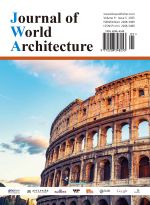Critical Regionalism for Ingratiation: China’s Foreign-Aided Stadiums After 2000
Abstract
Stadiums have been one of China’s most well-known and influential foreign aid projects that attract considerable attention. After 2000, a series of reforms in China’s foreign aid generated significant influences on the designs of China’s foreign-aided buildings, especially on large constructions such as stadiums. The authors aim to explore the development of China’s foreign-aided stadiums after 2000 and analyze the influential aspects on the design processes. Critical regionalism for ingratiation is identified as the main architectural feature. The study is conducted through a detailed analysis of the foreign aid mechanism, case projects, first-hand materials, and interviews with Chinese architects involved. The authors consider these stadiums to represent a unique critical regionalism with cultural and climate elements embedded. It can be regarded as a considerable supplement to the current scholarship on Chinese contemporary architecture and Chinese sports buildings.
References
Copper JF, 1979, China’s Foreign Aid in 1978, School of Law, University of Maryland.
Brautigam D, 2011, China in Africa: Seven myths. The Elcano Royal Institute/Real Instituto Elcano, Analysis of the Real Elcano Institute (ARI) 23/2011, Madrid, Spain 8.
Brautigam D, 2011, The Dragon’s Gift: The Real Story of China in Africa, Oxford University Press, New York.
Will R, 2011, China’s Stadium Diplomacy. World Policy Journal, 29(2): 36–43.
Doytchinov G, 2012, Pragmatism, not Ideology: Bulgarian Architectural Exports to the “Third World.” The Journal of Architecture, 17 (3): 453–473.
Siamphukdee C, 2014, Introduction: “Export Architecture” and the Cold War. Journal of Export Architecture: A War of the Worlds – Cold War Projects abroad. Deakin University, Deakin, 1–2.
Siamphukdee C, 2014, What have You Done? Typologies of Export Architecture. Journal of Export Architecture: A War of the Worlds – Cold War Projects Abroad, Deakin University, Deakin, 6–8.
Kacel E, 2010, This is not an American House: Good Sense Modernism in 1950s Turkey, in Lu D (ed.), Third World Modernism: Architecture, Development and Identity, Chapter 7, Routledge, London and New York, 165–185.
Sorokina Y, 2012, Ghost of a Garden City, in Ritter K (ed), Soviet Modernism 1955–1991: Unknown History, Park Books, Switzerland, 179–192.
Chang W, Xue CQL, 2018, A Brief Introduction to the Regional Design Attempt of China-aided Sports Buildings. Architecture and Culture, 10(175): 241–243.
Chang W, Xue C, 2019, Towards International-China-aid Stadiums in the Developing World. Frontiers of Architectural Research, 5: 604–619.
Chang W, Xue C, 2019, Cultural Expression in the Design of Aid Architecture - A Case Study of China-aided Architectural Practice in Cambodia. Urbanism and Architecture, 9(330): 26–29.
Chang W, Xue C, 2020, Climate, Standard and Symbolization: Critical Regional Approaches in Designs of China-aided Stadiums. Journal of Asian Architecture and Building Engineering.
Chang W, 2020, Aid, Sport and Architectural Exportation – a Study of China’s Foreign-aided Stadiums from the 1950s to the 21st Century, City University of Hong Kong.
Chang W, et al., 2024, From Labour Support to Design Support: Transition of China’s Foreign Aid Stadiums from the 1950s to the 1970s. Journal of Asian Architecture and Building Engineering, 1: 1–18.
Chang W, 2024, Architectural Development of China’s Foreign-aided Stadiums: 1956–2019, Tianjin University Press, Tianjin.
Strange A, Dreher A, Fuchs A, et al., 2017, Tracking Underreported Financial Flows: China’s Development Finance and the Aid–Conflict Nexus Revisited. Journal of Conflict Resolution, 61(5): 935–963.
The State Council of China, 2011, White Paper on China’s Foreign Aid. Beijing, China.
Liu F, 2016, The Historical Process and Realistic Development of China’s Foreign Aid. Jinan Journal (Philosophy and Social Sciences), (2): 120–128.
Kobayashi T, 2008, Evolution of China’s Aid Policy. JBICI Working Paper No. 27, Japan Bank for International Cooperation Institute, Tokyo.
Hubbard P, 2017, Aiding Transparency: What We Can Learn About China ExIm Bank’s Concessional Loans. CGD Working Paper 126, Centre for Global Development, Washington, DC.
Jiang H, 2007, National Stadium of Tanzania. Archicreation, 91(1): 50–55.
Meng X, Yan R, 2011, Membrane Structure Construction Technique in Tanzania Stadium Engineering. Architectural Technique, 42(07): 628–630.
Anonymous, 2006, Design and Experimental Analysis of Wanxiang Support in Tanzania National Stadium. Journal of Architectural Structure, 36(S1): 419–421.
Gu J, 2004, China’s Assistance to the Preservation of the Temple of Zhousa in Angkor, Cambodia. Proceedings of the Symposium on the Protection of Masonry Cultural Relics. China Association for the Protection of Cultural Relics.
Deng Y, 2018, On China’s Foreign Aid to Cambodia under the Belt and Road Strategy. Journal of Guangdong Agricultural and Industrial College of Technology, 34(01): 18–21.
Sun G, 2012, Cooperation between China and Cambodia, Hand in Hand, People’s Daily, March 30, 2012.

